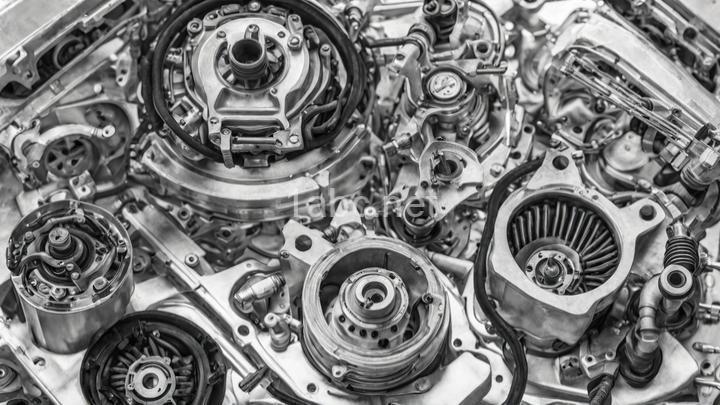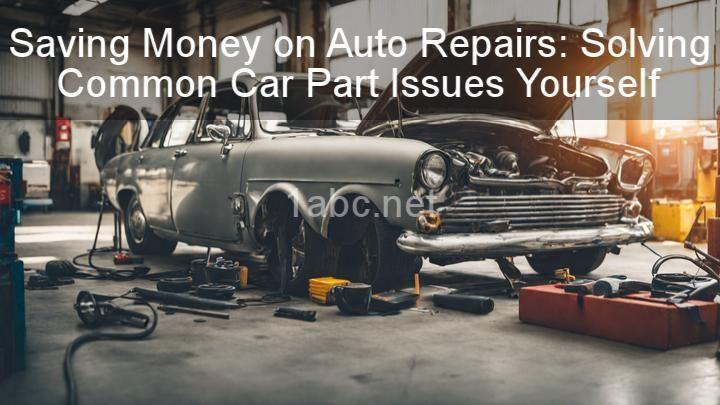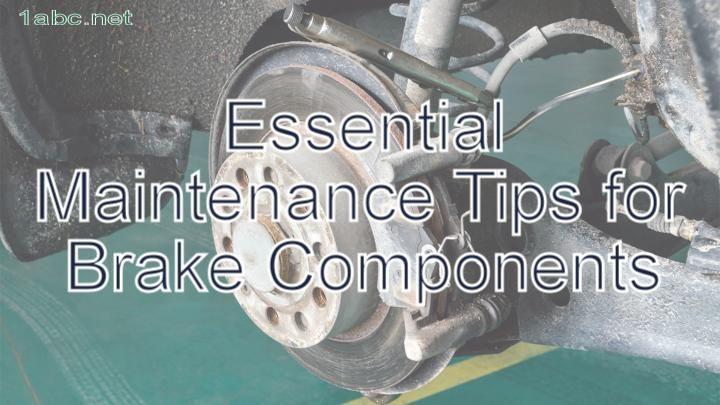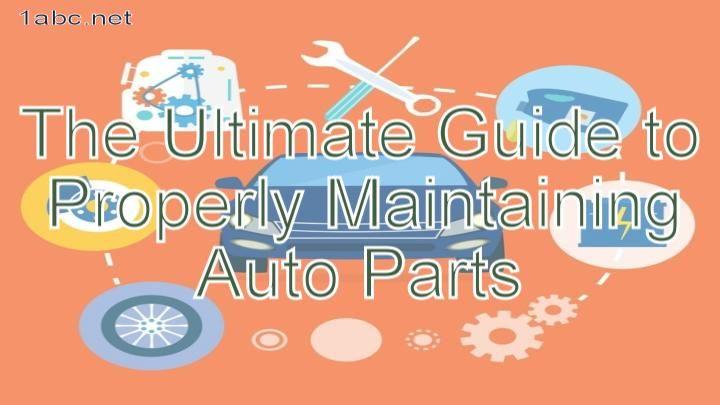How to Keep Your Engine Parts in Top Shape
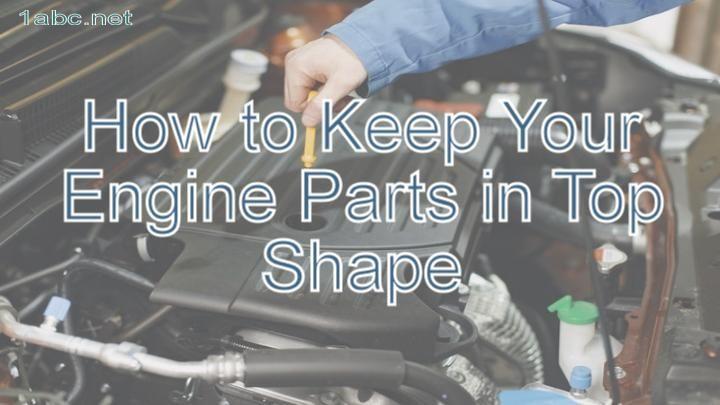
Introduction:
Welcome to our blog post on how to keep your engine parts in top shape! Whether you're a car enthusiast or simply someone who wants to take care of their vehicle, understanding the importance of maintaining engine parts is crucial for optimal performance. Regular maintenance not only ensures smooth operation but also enhances fuel efficiency and extends the longevity of your engine. In this blog, we will guide you through the essential steps to keep your engine parts in prime condition.
I. Understand Your Engine Parts
Before diving into maintenance practices, it's essential to understand the key engine parts and their functions. Your engine is a complex system with various components that work together harmoniously. Some of the critical engine parts include pistons, cylinder heads, and valves. The pistons move up and down within the cylinders, converting the energy from fuel combustion into mechanical motion. The cylinder heads seal the top of the cylinders, housing the valves that control the flow of air and fuel into the combustion chamber. It's important to recognize the interdependence of these parts for smooth operation and optimal performance.
II. Regular Inspection and Maintenance
A. Oil Changes
One of the most crucial aspects of engine maintenance is regular oil changes. Clean oil is vital for lubricating moving parts, reducing friction, and dissipating heat. Over time, oil breaks down and becomes contaminated with debris and particles, losing its effectiveness. It is recommended to change your oil every 3,000 to 5,000 miles, depending on your vehicle and driving conditions. Consult your owner's manual for the specific oil change interval and the type of oil suitable for your engine. Performing an oil change is relatively straightforward and can be done with a few tools and supplies. Here is a step-by-step guide on how to perform an oil change:
- Prepare your vehicle: Park on a level surface and engage the parking brake.
- Gather supplies: You will need a socket wrench, oil filter wrench, drain pan, new oil filter, and the appropriate amount and type of oil.
- Drain the old oil: Locate the oil drain plug beneath the engine and place the drain pan underneath. Loosen the drain plug with a socket wrench and allow the old oil to drain completely.
- Replace the oil filter: Use an oil filter wrench to remove the old oil filter. Apply a thin layer of new oil to the rubber gasket of the new oil filter and install it securely.
- Refill with new oil: Remove the oil cap on the engine, insert a funnel, and carefully pour in the new oil according to the recommended amount.
- Check the oil level: Start the engine and let it run for a few minutes. Turn off the engine and wait for a few minutes to allow the oil to settle. Check the oil level using the dipstick, ensuring it falls within the recommended range.
- Dispose of the old oil: Safely dispose of the old oil at a recycling center or an approved facility.
B. Air Filter Maintenance
Another critical aspect of engine maintenance is taking care of the air filter. The air filter prevents contaminants such as dirt, dust, and debris from entering the engine, ensuring clean air for combustion. Over time, the air filter accumulates dirt and becomes clogged, affecting engine performance and fuel efficiency. It is recommended to inspect the air filter every 12,000 to 15,000 miles and clean or replace it when necessary. Here are some tips on inspecting and maintaining your air filter: - Locate the air filter housing: Consult your owner's manual to find the air filter housing, usually located in the engine compartment.
- Remove the air filter: Open the air filter housing and carefully remove the air filter.
- Inspect the air filter: Examine the air filter for dirt, debris, and damage. If it appears dirty or clogged, it is time for maintenance.
- Clean or replace the air filter: If the air filter is reusable, clean it according to the manufacturer's instructions. If it is disposable, replace it with a new one.
- Reinstall the air filter: Place the cleaned or new air filter back into the housing, ensuring it is properly seated.
- Close the air filter housing: Securely close the air filter housing, ensuring there are no gaps or loose connections.
C. Spark Plug Care
Spark plugs play a crucial role in ignition and combustion. They create the spark that ignites the air-fuel mixture in the combustion chamber, producing the power needed to propel your vehicle. Over time, spark plugs wear out and may cause misfires, reduced fuel efficiency, and difficulty starting the engine. It is recommended to check the spark plug condition every 30,000 to 50,000 miles and replace them if necessary. Here are the instructions for checking spark plug condition and proper replacement techniques: - Locate the spark plugs: Depending on your vehicle, the spark plugs may be accessible on the top or side of the engine. Consult your owner's manual for their specific location.
- Remove the spark plugs: Use a spark plug socket and a ratchet to carefully remove the spark plugs, one at a time.
- Inspect the spark plugs: Examine the spark plugs for signs of wear, such as erosion, deposits, or damage. If they appear worn out or damaged, they should be replaced.
- Gap and replace the spark plugs: If the spark plugs are in good condition, check the electrode gap using a spark plug gap tool. Adjust the gap as necessary. Install the new spark plugs by hand, ensuring they are threaded correctly. Finish tightening them with a spark plug socket and ratchet, being careful not to overtighten.
- Repeat for all spark plugs: Repeat the process for all spark plugs, ensuring they are all in good condition and properly installed.
- Dispose of old spark plugs: Safely dispose of the old spark plugs at a recycling center or an approved facility.
III. Cooling System Maintenance
The cooling system plays a crucial role in preventing engine overheating, which can lead to severe damage. Proper maintenance of the cooling system helps maintain the engine's operating temperature within the recommended range. Here are two essential cooling system maintenance tasks:
A. Coolant Level Check
Maintaining proper coolant levels is vital for optimal engine performance and preventing overheating. Coolant, also known as antifreeze, helps regulate the engine's temperature and prevents freezing in cold climates. It is essential to regularly check the coolant level and refill if necessary. Here is a detailed guide on how to check and refill coolant:
- Park your vehicle on a level surface and allow the engine to cool completely.
- Locate the coolant reservoir: The coolant reservoir is a plastic tank usually located near the radiator. Consult your owner's manual for its specific location.
- Check the coolant level: The coolant reservoir has markings indicating the minimum and maximum levels. The coolant level should fall between these markings. If it is below the minimum level, it needs to be refilled.
- Refill the coolant: If the coolant level is low, slowly pour the recommended type of coolant into the reservoir until it reaches the maximum level.
- Securely close the coolant reservoir: Ensure the coolant reservoir cap is securely closed to prevent leaks.
B. Radiator Cleaning
Regular radiator cleaning is essential to remove debris and prevent clogs that can hinder proper airflow and lead to engine overheating. Here are the steps to safely clean debris from the radiator fins: - Ensure the engine is cool: It's crucial to perform radiator cleaning when the engine is cool to avoid burns.
- Locate the radiator: The radiator is typically located at the front of the engine compartment.
- Remove debris: Use a soft brush or compressed air to gently remove debris, such as leaves, bugs, and dust, from the radiator fins. Be careful not to damage the delicate fins.
- Flush with water: Use a hose or pressure washer on a low setting to flush the radiator fins with water, removing any remaining debris.
- Reinspect and repeat if necessary: Inspect the radiator fins again to ensure all debris is removed. If necessary, repeat the cleaning process until the fins are clean.
IV. Fuel System Maintenance
A. Fuel Filter Replacement
A clean fuel filter is essential for fuel efficiency, preventing contaminants from reaching the engine and causing damage. Over time, the fuel filter becomes clogged and needs to be replaced. Here is a guide on identifying when it's time to replace the fuel filter:
- Consult your owner's manual: Refer to your owner's manual for the recommended fuel filter replacement interval.
- Observe symptoms: Look out for signs that indicate a clogged fuel filter, such as reduced engine performance, difficulty starting the engine, or frequent stalling. If you experience any of these symptoms, it's time to replace the fuel filter.
- Locate the fuel filter: The fuel filter is typically located along the fuel line, either in the engine compartment or underneath the vehicle. Consult your owner's manual for its specific location.
- Prepare the vehicle: Park on a level surface, engage the parking brake, and disconnect the fuel pump fuse or relay to relieve fuel pressure.
- Replace the fuel filter: Use a wrench or a fuel filter removal tool to carefully disconnect the fuel lines from the old fuel filter. Install the new fuel filter by connecting the fuel lines securely.
- Reconnect the fuel pump fuse or relay: Once the new fuel filter is installed, reconnect the fuel pump fuse or relay.
- Start the engine: Start the engine and check for any fuel leaks. Ensure the engine runs smoothly and without any issues.
B. Fuel Injector Cleaning
Fuel injectors play a crucial role in delivering fuel into the combustion chamber for combustion. Over time, fuel injectors can become clogged or dirty, affecting fuel atomization and engine performance. Here are some symptoms indicating dirty fuel injectors and options for cleaning or professional service recommendations: - Observe symptoms: Look out for signs of dirty fuel injectors, such as rough idling, reduced fuel efficiency, decreased acceleration, or engine misfires. If you notice any of these symptoms, it's time to consider fuel injector cleaning.
- DIY fuel injector cleaner: There are various fuel injector cleaning solutions available that can be added to your fuel tank. Follow the instructions on the product to safely clean the fuel injectors as you drive.
- Professional fuel injector cleaning: If the DIY method does not resolve the issue, or if you prefer a more thorough cleaning, consider professional fuel injector cleaning. A professional service provider can use specialized equipment to clean the fuel injectors and restore their optimal performance.
V. Other Important Considerations
A: Drive Smoothly and Avoid Excessive Idling
In addition to regular maintenance, adopting fuel-efficient driving habits is crucial for the longevity of your engine. Aggressive driving, such as rapid acceleration and hard braking, puts unnecessary stress on the engine and its components. Similarly, excessive idling can waste fuel and contribute to engine wear. By driving smoothly and avoiding excessive idling, you can reduce wear and tear on your engine and improve fuel efficiency.
B: Regular Check-Ups with a Mechanic
While regular maintenance tasks can be performed by vehicle owners, it's still important to schedule regular check-ups with a mechanic. A professional inspection can catch potential issues early on and provide expert advice on any necessary repairs or maintenance. By partnering with a trusted mechanic, you can ensure that your engine parts are in top shape and enjoy peace of mind while driving.
Conclusion:
Keeping your engine parts in top shape is essential for optimal performance, efficiency, and longevity. By following the guidelines outlined in this blog post, you can take proactive steps to maintain your engine parts and enjoy a smooth and reliable driving experience. Regular oil changes, air filter maintenance, spark plug care, cooling system maintenance, fuel system maintenance, and adopting fuel-efficient driving habits are all key components of maintaining your engine's health. Remember, a well-maintained engine will reward you with improved performance, enhanced fuel efficiency, and a longer lifespan. So, take action today and start implementing these maintenance practices to keep your engine parts in top shape!
FREQUENTLY ASKED QUESTIONS
What are some essential engine maintenance tips?
Proper engine maintenance is crucial for the longevity and performance of your vehicle. Here are some essential tips to keep your engine in good shape:
- Regular Oil Changes: Follow the manufacturer's recommended oil change intervals. Fresh oil lubricates the engine, reduces wear, and helps maintain correct engine temperatures.
- Check and Top-Up Fluids: Regularly check the levels of essential fluids such as coolant, transmission fluid, brake fluid, and power steering fluid. Proper fluid levels are essential for optimal engine performance.
- Replace Air Filters: Dirty air filters can restrict airflow to the engine, reducing fuel efficiency and performance. Replace them regularly as recommended by the manufacturer.
- Maintain Cooling System: Ensure that the engine coolant is at the correct level and mix. Replace coolant as recommended to prevent overheating and potential engine damage.
- Spark Plug Maintenance: Spark plugs provide the spark necessary for combustion in the engine. Periodically check and replace them according to the manufacturer's recommendations for improved fuel efficiency.
- Battery Care: Keep the battery terminals clean and free from corrosion. Check the battery's state regularly, and replace it when necessary to prevent engine starting issues.
- Monitor Belts and Hoses: Inspect belts and hoses for signs of wear, cracks, or leaks. Replace them if needed to avoid engine overheating or other mechanical failures.
- Follow the Maintenance Schedule: Adhere to the manufacturer's recommended maintenance schedule. This includes regular tune-ups, inspections, and other service intervals specific to your vehicle.
Remember, engine maintenance is essential, but always refer to your vehicle's owner's manual for specific maintenance instructions and recommended intervals.
How often should I change my engine oil?
It is generally recommended to change your engine oil every 3,000 to 5,000 miles or every 3 to 6 months, whichever comes first. However, the exact interval may vary depending on factors such as your driving habits, the type of vehicle you have, and the type of oil being used. It's best to consult your vehicle's owner's manual for the manufacturer's recommended oil change interval specific to your vehicle. Regular oil changes are important to maintain the health and longevity of your engine.
What type of oil is best for my engine?
Choosing the best type of oil for your engine depends on several factors such as the age and mileage of your vehicle, the climate you drive in, and the manufacturer's recommendations. In general, it is recommended to use the viscosity grade specified in your vehicle's owner's manual. Common types of engine oil include conventional (mineral) oil, synthetic oil, and synthetic blend oil. Synthetic oils are known to offer better protection and performance in extreme temperatures and can help maximize the longevity of your engine. It's always a good idea to consult your vehicle's owner's manual or speak with a professional mechanic to determine the best oil type for your specific engine.
How can I prevent overheating in my engine?
To prevent overheating in your engine, you can follow these steps:
1. Ensure Proper Cooling System Maintenance:
- Regularly check the coolant level and top it up if needed.
- Change the coolant as per your vehicle manufacturer's recommendation.
- Inspect hoses and belts for any signs of damage or leaks.
- Replace the thermostat if it is not functioning properly.
2. Monitor Engine Temperature:
- Keep an eye on your dashboard temperature gauge while driving.
- If you notice the temperature rising above the normal range, stop your vehicle and let it cool down before continuing.
3. Avoid Overloading and Extreme Conditions:
- Avoid overloading your vehicle with excessive weight.
- When driving in extreme conditions, such as on steep hills or in high temperatures, take extra precautions to prevent engine strain.
4. Maintain Proper Airflow:
- Keep the radiator grille and air vents clean from debris or obstructions.
- Ensure that the cooling fans are functioning correctly.
- Check that the radiator fins are not blocked or bent.
5. Avoid Extended Idling:
- Prolonged idling can lead to excessive heat buildup.
- If you need to stop for an extended period, such as for a break, it's better to turn off the engine.
6. Regular Engine Maintenance:
- Follow your vehicle manufacturer's recommended maintenance schedule for regular engine checks, including oil changes and spark plug replacements.
Following these steps can help prevent engine overheating and ensure the optimal performance and longevity of your vehicle.
Is it necessary to replace the engine air filter regularly?
Yes, it is necessary to replace the engine air filter regularly. The engine air filter is responsible for preventing dust, dirt, and other contaminants from entering the engine. Over time, the filter can become clogged with debris, reducing its effectiveness and potentially causing damage to the engine. Regularly replacing the air filter helps maintain optimal engine performance, fuel efficiency, and overall engine health. It is recommended to check the manufacturer's guide or consult a professional to determine the appropriate replacement interval for your specific vehicle.
When should I replace my spark plugs?
It is generally recommended to replace spark plugs every 30,000 to 100,000 miles, depending on the type of spark plugs you have in your vehicle. It's also a good idea to consult your vehicle's owner manual for the manufacturer's specific recommendations. Additionally, if you notice any signs of wear or poor performance such as misfires, rough idling, difficulty starting, or reduced fuel efficiency, it may be time to replace your spark plugs.
How do I know if my engine has a coolant leak?
There are a few signs that can indicate a coolant leak in your engine. Here are some things to look out for:
- Overheating: If your engine is constantly overheating, it could be a sign of a coolant leak. The coolant helps regulate the engine temperature, and if there's a leak, the coolant level will drop, causing the engine to overheat.
- Sweet smell: A coolant leak often produces a sweet smell, similar to maple syrup. If you notice this odor around your engine or inside your car, it could be an indication of a coolant leak.
- Coolant puddles: Check under your car after it has been parked for a while. If you notice colorful or greenish fluid pooling on the ground, it is likely coolant leaking from your engine.
- Low coolant level: Periodically check your coolant reservoir or radiator to ensure that the coolant level is within the recommended range. If it consistently drops below the optimal level, there may be a leak.
- White exhaust smoke: If you see white smoke coming from your exhaust pipe, it could be a sign of a coolant leak. Coolant can enter the combustion chamber and mix with the fuel, resulting in white smoke.
If you notice any of these signs, it is important to address the issue promptly. A coolant leak can lead to engine damage and should be repaired by a qualified mechanic.
